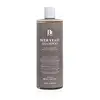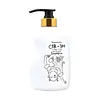What's inside
What's inside
 Key Ingredients
Key Ingredients

 Benefits
Benefits

 Concerns
Concerns

 Ingredients Side-by-side
Ingredients Side-by-side

Water
Skin ConditioningSaccharomyces Cerevisiae Extract
Skin ConditioningDisodium Laureth Sulfosuccinate
CleansingCocamidopropyl Hydroxysultaine
CleansingLauryl Glucoside
CleansingCocamide Mipa
EmulsifyingSodium Cocoyl Isethionate
CleansingLactobacillus/Leaf Ferment Filtrate
Skin ConditioningButylene Glycol
HumectantSodium Chloride
MaskingDipropylene Glycol
HumectantPolyquaternium-10
1,2-Hexanediol
Skin ConditioningGlycerin
HumectantPropolis Extract
Skin ConditioningGlycine Max Seed Extract
Skin ConditioningMalt Extract
Skin ProtectingPhellodendron Amurense Bark Extract
Skin ConditioningDipotassium Glycyrrhizate
HumectantBiotin
AntiseborrhoeicCamellia Sinensis Leaf Extract
AntimicrobialHouttuynia Cordata Extract
Skin ConditioningPerilla Frutescens Leaf Extract
MaskingAvena Sativa Kernel Extract
AbrasiveHydroxyacetophenone
AntioxidantCaffeine
Skin ConditioningMenthol
MaskingCaprylyl Glycol
EmollientPanthenol
Skin ConditioningSalicylic Acid
MaskingCoconut Acid
CleansingCitric Acid
BufferingNiacinamide
SmoothingSodium Isethionate
CleansingEthylhexylglycerin
Skin ConditioningSodium Gluconate
Skin ConditioningArginine
MaskingParfum
MaskingWater, Saccharomyces Cerevisiae Extract, Disodium Laureth Sulfosuccinate, Cocamidopropyl Hydroxysultaine, Lauryl Glucoside, Cocamide Mipa, Sodium Cocoyl Isethionate, Lactobacillus/Leaf Ferment Filtrate, Butylene Glycol, Sodium Chloride, Dipropylene Glycol, Polyquaternium-10, 1,2-Hexanediol, Glycerin, Propolis Extract, Glycine Max Seed Extract, Malt Extract, Phellodendron Amurense Bark Extract, Dipotassium Glycyrrhizate, Biotin, Camellia Sinensis Leaf Extract, Houttuynia Cordata Extract, Perilla Frutescens Leaf Extract, Avena Sativa Kernel Extract, Hydroxyacetophenone, Caffeine, Menthol, Caprylyl Glycol, Panthenol, Salicylic Acid, Coconut Acid, Citric Acid, Niacinamide, Sodium Isethionate, Ethylhexylglycerin, Sodium Gluconate, Arginine, Parfum
Water
Skin ConditioningLauryl Betaine
CleansingDisodium Laureth Sulfosuccinate
CleansingGlycerin
HumectantSodium Chloride
MaskingDipropylene Glycol
HumectantPEG-12 Dimethicone
Skin ConditioningPolyquaternium-10
Sodium Cocoyl Glutamate
CleansingPolyquaternium-67
Parfum
MaskingPEG-12 Allyl Ether
Citric Acid
Buffering1,2-Hexanediol
Skin ConditioningCaprylyl Glycol
EmollientButylene Glycol
HumectantDisodium Cocoyl Glutamate
CleansingPolyquaternium-11
Sodium Benzoate
MaskingIllicium Verum Fruit Extract
PerfumingDisodium EDTA
Polyquaternium-7
Ceramide NP
Skin ConditioningHydrolyzed Collagen
EmollientDecyl Glucoside
CleansingGelatin
Hydrolyzed Keratin
HumectantAvena Sativa Protein Extract
Skin ConditioningHydrolyzed Corn Protein
Skin ConditioningHydrolyzed Soy Protein
HumectantHydrolyzed Wheat Protein
Skin ConditioningMoringa Oleifera Seed Extract
Skin ConditioningPropolis Extract
Skin ConditioningSalix Alba Bark Extract
AstringentOriganum Vulgare Leaf Extract
Skin ConditioningChamaecyparis Obtusa Leaf Extract
Skin ConditioningLactobacillus/Soybean Ferment Extract
Skin ConditioningCinnamomum Cassia Bark Extract
MaskingScutellaria Baicalensis Root Extract
AstringentPortulaca Oleracea Extract
Skin ConditioningBeta-Glucan
Skin ConditioningWater, Lauryl Betaine, Disodium Laureth Sulfosuccinate, Glycerin, Sodium Chloride, Dipropylene Glycol, PEG-12 Dimethicone, Polyquaternium-10, Sodium Cocoyl Glutamate, Polyquaternium-67, Parfum, PEG-12 Allyl Ether, Citric Acid, 1,2-Hexanediol, Caprylyl Glycol, Butylene Glycol, Disodium Cocoyl Glutamate, Polyquaternium-11, Sodium Benzoate, Illicium Verum Fruit Extract, Disodium EDTA, Polyquaternium-7, Ceramide NP, Hydrolyzed Collagen, Decyl Glucoside, Gelatin, Hydrolyzed Keratin, Avena Sativa Protein Extract, Hydrolyzed Corn Protein, Hydrolyzed Soy Protein, Hydrolyzed Wheat Protein, Moringa Oleifera Seed Extract, Propolis Extract, Salix Alba Bark Extract, Origanum Vulgare Leaf Extract, Chamaecyparis Obtusa Leaf Extract, Lactobacillus/Soybean Ferment Extract, Cinnamomum Cassia Bark Extract, Scutellaria Baicalensis Root Extract, Portulaca Oleracea Extract, Beta-Glucan
 Reviews
Reviews

Ingredients Explained
These ingredients are found in both products.
Ingredients higher up in an ingredient list are typically present in a larger amount.
1,2-Hexanediol is a synthetic liquid and another multi-functional powerhouse.
It is a:
- Humectant, drawing moisture into the skin
- Emollient, helping to soften skin
- Solvent, dispersing and stabilizing formulas
- Preservative booster, enhancing the antimicrobial activity of other preservatives
Butylene Glycol (or BG) is used within cosmetic products for a few different reasons:
Overall, Butylene Glycol is a safe and well-rounded ingredient that works well with other ingredients.
Though this ingredient works well with most skin types, some people with sensitive skin may experience a reaction such as allergic rashes, closed comedones, or itchiness.
Learn more about Butylene GlycolCaprylyl Glycol is a humectant and emollient, meaning it attracts and preserves moisture.
It is a common ingredient in many products, especially those designed to hydrate skin. The primary benefits are retaining moisture, skin softening, and promoting a healthy skin barrier.
Though Caprylyl Glycol is an alcohol derived from fatty acids, it is not the kind that can dry out skin.
This ingredient is also used as a preservative to extend the life of products. It has slight antimicrobial properties.
Learn more about Caprylyl GlycolCitric Acid is an alpha hydroxy acid (AHA) naturally found in citrus fruits like oranges, lemons, and limes.
Like other AHAs, citric acid can exfoliate skin by breaking down the bonds that hold dead skin cells together. This helps reveal smoother and brighter skin underneath.
However, this exfoliating effect only happens at high concentrations (20%) which can be hard to find in cosmetic products.
Due to this, citric acid is usually included in small amounts as a pH adjuster. This helps keep products slightly more acidic and compatible with skin's natural pH.
In skincare formulas, citric acid can:
While it can provide some skin benefits, research shows lactic acid and glycolic acid are generally more effective and less irritating exfoliants.
Most citric acid used in skincare today is made by fermenting sugars (usually from molasses). This synthetic version is identical to the natural citrus form but easier to stabilize and use in formulations.
Read more about some other popular AHA's here:
Learn more about Citric AcidDipropylene Glycol is a synthetically created humectant, stabilizer, and solvent.
This ingredient helps:
Dipropylene glycol is technically an alcohol, but it belongs to the glycol family (often considered part of the ‘good’ alcohols). This means it is hydrating and gentle on skin unlike drying solvent alcohols like denatured alcohol.
As a masking agent, Dipropylene Glycol can be used to cover the smell of other ingredients. However, it does not have a scent.
Studies show Dipropylene Glycol is considered safe to use in skincare.
Learn more about Dipropylene GlycolThis ingredient is a cleansing agent, surfactant, and foam booster. It considered an alternative to traditional sulfates (Sulfosuccinate) and is allowed in "sulfate-free" products.
According to a manufacturer, this ingredient is mild and can be used in baby and bath options.
Glycerin is already naturally found in your skin. It helps moisturize and protect your skin.
A study from 2016 found glycerin to be more effective as a humectant than AHAs and hyaluronic acid.
As a humectant, it helps the skin stay hydrated by pulling moisture to your skin. The low molecular weight of glycerin allows it to pull moisture into the deeper layers of your skin.
Hydrated skin improves your skin barrier; Your skin barrier helps protect against irritants and bacteria.
Glycerin has also been found to have antimicrobial and antiviral properties. Due to these properties, glycerin is often used in wound and burn treatments.
In cosmetics, glycerin is usually derived from plants such as soybean or palm. However, it can also be sourced from animals, such as tallow or animal fat.
This ingredient is organic, colorless, odorless, and non-toxic.
Glycerin is the name for this ingredient in American English. British English uses Glycerol/Glycerine.
Learn more about GlycerinParfum is a catch-all term for an ingredient or more that is used to give a scent to products.
Also called "fragrance", this ingredient can be a blend of hundreds of chemicals or plant oils. This means every product with "fragrance" or "parfum" in the ingredients list is a different mixture.
For instance, Habanolide is a proprietary trade name for a specific aroma chemical. When used as a fragrance ingredient in cosmetics, most aroma chemicals fall under the broad labeling category of “FRAGRANCE” or “PARFUM” according to EU and US regulations.
The term 'parfum' or 'fragrance' is not regulated in many countries. In many cases, it is up to the brand to define this term.
For instance, many brands choose to label themselves as "fragrance-free" because they are not using synthetic fragrances. However, their products may still contain ingredients such as essential oils that are considered a fragrance by INCI standards.
One example is Calendula flower extract. Calendula is an essential oil that still imparts a scent or 'fragrance'.
Depending on the blend, the ingredients in the mixture can cause allergies and sensitivities on the skin. Some ingredients that are known EU allergens include linalool and citronellol.
Parfum can also be used to mask or cover an unpleasant scent.
The bottom line is: not all fragrances/parfum/ingredients are created equally. If you are worried about fragrances, we recommend taking a closer look at an ingredient. And of course, we always recommend speaking with a professional.
Learn more about ParfumPolyquaternium-10 is an ammonium salt of hydroxyethylcellulose. It is a white and granular powder used as a film-former and anti-static agent.
This ingredient is commonly found in hair conditioning products. According to a manufacturer, its positive charge makes it great for absorbing hair proteins. The manufacturer also states this ingredient helps with curl retention.
For haircare friends: this ingredient is not a silicone.
Learn more about Polyquaternium-10Propolis Extract is also known as bee glue.
This ingredient has antimicrobial, anti-inflammatory, wound healing, and antioxidant properties.
Studies show propolis helps fight against bacteria, viruses, and fungi. This may help with reducing acne and accelerate wound healing.
The flavonoids found in propolis extract are potent antioxidants. Antioxidants may help with reducing the signs of aging.
A study from 2020 found propolis to help reverse skin damage from UV.
Fun facts: This ingredient is created by mixing beeswax, bee saliva, and parts of trees. Bees use propolis as a sealant to close any gaps in their hives.
Since it is an animal-derived product, this ingredient is not considered vegan. For vegan alternatives, check out Galactomyces Ferment Filtrate or Centella Asiatica Extract.
Learn more about Propolis ExtractChances are, you eat sodium chloride every day. Sodium Chloride is also known as table salt.
This ingredient has many purposes in skincare: thickener, emulsifier, and exfoliator.
You'll most likely find this ingredient in cleansers where it is used to create a gel-like texture. As an emulsifier, it also prevents ingredients from separating.
There is much debate on whether this ingredient is comedogenic. The short answer - comedogenic ratings don't tell the whole story. Learn more about comegodenic ratings here.
The concensus about this ingredient causing acne seems to be divided. Research is needed to understand if this ingredient does cause acne.
Scrubs may use salt as the primary exfoliating ingredient.
Learn more about Sodium ChlorideWater. It's the most common cosmetic ingredient of all. You'll usually see it at the top of ingredient lists, meaning that it makes up the largest part of the product.
So why is it so popular? Water most often acts as a solvent - this means that it helps dissolve other ingredients into the formulation.
You'll also recognize water as that liquid we all need to stay alive. If you see this, drink a glass of water. Stay hydrated!
Learn more about Water